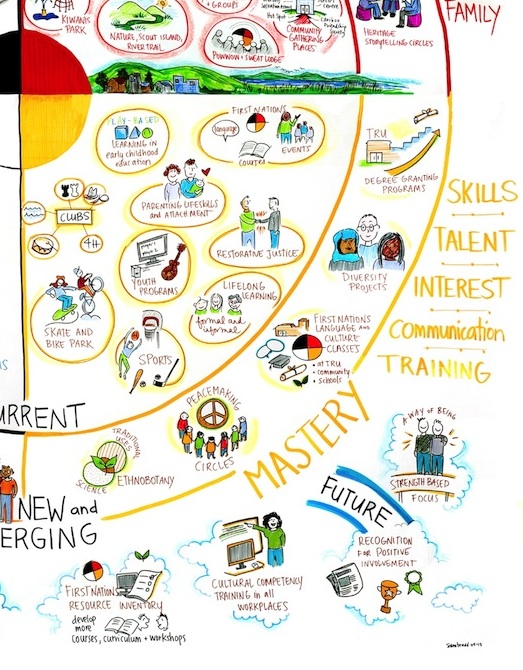Drawing for Healing- Truth and Reconciliation in Williams Lake

Earlier this year, members of the Communities That Care group brought the esteemed Dr. Martin Brokenleg for a workshop about the Circle of Courage. At his workshop, participants brainstormed lists of important activities happening in the Cariboo Chilcotin. But lists are only as powerful as how they are used, so the committee thought an image would be an effective way to followup with the community about the groups’ progress. They contacted me and my task was to breathe life into the lists. Art can speak to the heart and connect to emotion in way that lists can’t.
I was commissioned to create a very large drawing (6 x 6 feet – for a total of 36 sq feet) that visualizes and supports community resilience. For me, it is a contribution of art towards healing, truth and reconciliation. It was revealed on May 16-17 as part of the “Commemoration Conference and Town Hall on Reconciliation” with the Truth and Reconciliation Commission (TRC) in the Cariboo Chilcotin. Held on the traditional territories of the T’exelcemc, Tsilhqot’in and Carrier Nations, the event brought together former students of Indian Residential Schools, their families and others who were affected to share their experiences with the TRC.
Creating Together
I worked on the commission long-distance from Vancouver with a committee of Communities That Care members. I felt we took care to create an ethical collaboration because of the strong direction from the committee. We drafted a layout based on the medicine wheel and the Circle of Courage. The wheel has three rings: the inner ring for current events (eg clubs and youth activities), the middle ring for new emerging activities (eg residential school reunion, food programs at schools), and the outside ring for future hopes (First Nations resource inventory, strength-based focus as a way of being). There are dozens of tiny images for different activities, each probably representing thousands of volunteer-led hours.
The final image is six feet wide and six feet tall. A section of it is posted above. It was revealed at the TRC event “Town Hall on Reconciliation – What Does Reconciliation Mean to the Cariboo Region”, with Dr. Martin Brokenleg returning to Williams Lake. His keynote was on Mobilizing Community. As a committee member told me, “we wanted him to refer to the circle, the work that has been happening, and inspire people to continue to be involved in terms of moving things forward.” I was happy to hear that Dr. Brokenleg was pleased that the community had used his model and transformed it in a way that became their own.
When I sat down this morning to write about our collaboration, it was a coincidence that at the same time I heard “Williams Lake” on the radio. Xatsu’ll chief Bev Sellars was talking about her new memoir, They Called Me Number 1: Secrets and Survival at an Indian Residential School. When she says in her family everyone who is her age and older went to residential school, I feel a stab in my heart. The effects of abuse, forced separation from family and culture, and being forbidden to speak her language or name are long-lasting beyond the years spent at the school. Broken children return home to raise the next generation. Her story is of family survival and healing. And painful stories like this, importantly, are being told in a context of indigenous resilience and community healing. I might live far away from the Cariboo Chilcotin, but as a white person living in Canada I’m connected to this part of Canada’s history. We all are. It’s not something that happened a long time ago: the effects of residential schools are still with us; systemic and structural causes of racism are still with us. Before we move forward, we have to acknowledge the past. As the TRC says, “The truth of our common experiences will help set our spirits free and pave the way to reconciliation.”
It’s not a perfect drawing by any means. I could have made a digital poster, but I believe because this drawing is made by hand it has a different impact. The handmade quality reminds the viewer of the human connection from the artist reaching out to the community, and to the community reaching out to each other. A digital poster might look too ‘perfect’ or finished. The way it’s made is part of the process, and the process is ongoing.
Which is all to say, I was honored to support the event with visuals.